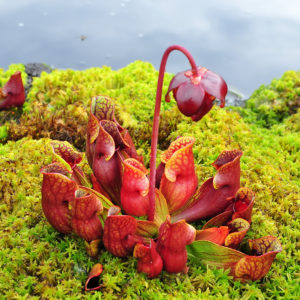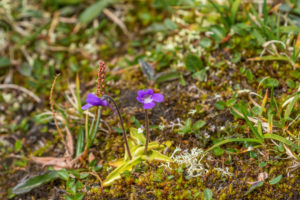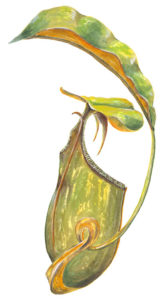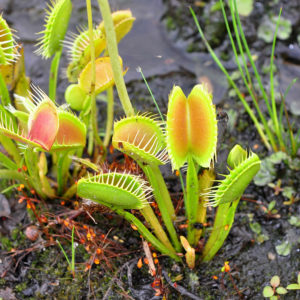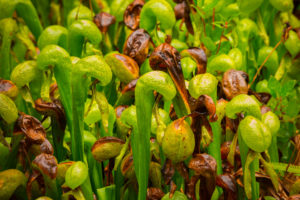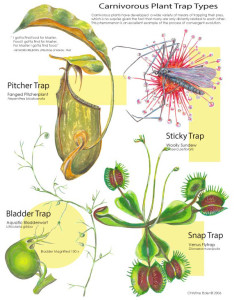May 4th is World Carnivorous Plant Day!
What Are Carnivorous Plants?
Read on to discover the fascinating world of carnivorous plants; their diversity, ecology, and distribution, then watch a video I made about my favorite species from Malaysia!
- Carnivorous plants are species that attract, catch and digest animal prey. Some of the well-known varieties include the venus flytrap, sundew, pitcher plant, butterwort, and bladderwort – all of which can be found in the United States, as well as elsewhere in boggy wetlands throughout the world.
- These cunning plants have been known to dine, not only on insects, but arachnids, mollusks, worms, and small fish. Even amphibians, reptiles, rodents, and birds sometimes fall prey to them.
- First, they attract unsuspecting victims with such deceptive methods as colorful leaves, enticing scents, and sweet nectars.
- Next, they trap the victims with a variety of grisly methods including sticky hairs, greasy or strategically cupped leaves, sharp thorns, or leaves that snap shut like a bear trap.
- The Bladderwort – an aquatic carnivorous plant that floats in ponds, has a spring-loaded trap door that sucks in its prey at one of the fastest speeds in the plant kingdom. As a final blow, they digest their prey. Many of them use enzymes (similar to those found in our own stomachs) to penetrate the exoskeletons of their prey (and thus turn their insides to goo), while others, such as the ominously named Cobra Lily, have accomplices such as midge larvae and mites that assist in breaking down the insects’ hard exteriors.
- There are over 450 different species of carnivorous plants on every continent, with the exception of Antarctica. Many live in swampy bogs, others are epiphytes, and a few are aquatic, like the Bladderwort.
- The aptly named Fanged Pitcher-Plant is among the largest of all carnivorous plants, with pitchers over a foot long. It lives in the dark, dank peat swamps of Borneo where it feeds on ants, though some early explorers believed it fed on rats and monkeys because these would purportedly be found, drowned inside their pitchers!Its name refers to the fact that it has a hollow cup that is as large as a milk pitcher with some species’ pitchers growing over a foot long! This species has a unique pair of fang-like appendages hanging down from the base of the lid which drips with viscous nectar that insects find irresistible.Greedy insects that venture too far slip into the liquid-filled pitcher drown, after which they are digested by the pitcher plant as a source of vital nutrients.
- The Sundew is so named for its glistening droplets of sticky secretions that trap prey as large as craneflies. The more the insect struggles, the more sealed is its fate. Charles Darwin studies a species of European sundew and wrote a book about it, claiming to care more about sundews than the topic of evolution!

Sundew with trapped cranefly illustration by Christine
- The flesh-eating round-leaved sundew is a diminutive but deadly cousin of the Venus flytrap. Its proper names come from the Greek word meaning “dewy,” a reference to the plant’s glistening droplets of sticky liquid mounted at the tips of touch-sensitive tentacles. Resembling sweet-smelling crystal balls, they serve to fatally attract all manner of flying insects.
- The hapless creature that alights on this surface begins a futile struggle to free itself from adhesive bonds that are like living flypaper. The more the prey panics, the more its fate is sealed- because each movement signals the sundew to releases yet more of the glue-like substance. The tentacle-bearing leaf blade encircles the now-entombed prey by a process of nearly instantaneous growth, simultaneously engulfing it in digestive juices. Within several days all that remains of the sundew’s meal are the undigestible wings and exoskeleton.
Explained by Darwin
Charles Darwin was the first to demonstrate the plant’s carnivorous feature when he conducted experiments in 1860 proving the juices it secretes are similar to the enzymes found in the stomachs of animals. Why would a plant opt for such a specialized lifestyle? Because most carnivorous plant species reside on nutrient-poor soils. These environments also are largely competitor-free habitats, where carnivores thrive on nutrient-rich insects.
Many carnivorous plants are endangered due to loss of habitat, pollution, and increased black market poaching – including the Venus Fly Trap, native only to North and South Carolina.
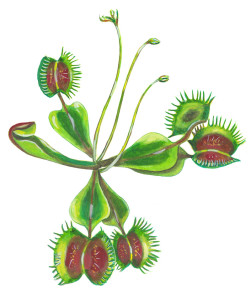
Venus Flytrap, illustration by Christine Elder
Adventures with Carnivorous Plants
I fell in love with the fascinating world of carnivorous plants in college, when I conducted my master’s thesis research on a species endemic to California and Oregon, Darlingtonia californica. The plant has a symbiotic relationship with a type of mosquito known as a midge whose larvae live inside the tubular pitcher of the plant. Learn more about the midge HERE.
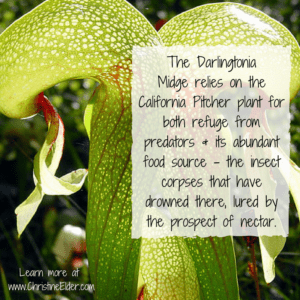
Looking at the photo below, you can easily imagine how the plant got its common name, Cobra Lily, with its tubular body arching like a snake and its pair of fangs poised to strike the unsuspecting visitor!
I’ve been lucky to observe many species of carnivorous plants out in buggy bogs and water-logged wetlands like the one pictured below on the island of Borneo. Borneo has over 30 species of pitcher plants in the genus Nepenthes, distributed in a wide variety of habitats.
The island is the world’s center of diversity for this group of carnivorous plants. I found them both in the highlands of Mount Kinabalu and the lowland rainforests of the Kinabatangan River delta, where I filmed the video below.
LEARN MORE about CARNIVOROUS PLANTS
–The flesh-eating round-leaved sundew
–The tale of the Darlingtonia midge
–The living, breathing world of Borneo’s carnivorous pitcher plants
–How to draw a Nepenthes pitcher plant: A video tutorial.
Download this Carnivorous Plant Trap Types poster. All botanical illustrations by Christine Elder.
Time-lapse video of how to draw a pitcher plant
Did You Enjoy This Story?
If you’ve found value in this story and believe in my mission to educate youth and adults alike on the value of nature, I invite you to make a donation to help broaden and deepen the work I can accomplish.
Click the Paypal ‘Donate’ button below to donate any amount you wish to support the conservation and education work I do. You don’t need to have a Paypal account to donate, you may also choose to use a credit card, or simply send put a check in the mailbox if you wish. Thank you!


